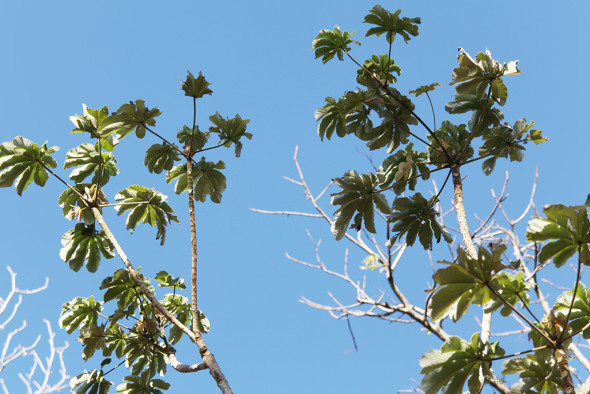The Remarkable Trees of Nosara

Cecropia
I recently wrote a short post about the great bird-watching day we recently had in Nosara—while on a hike with the deeply knowledgeable Felipe, a conservation biologist studying biodiversity in Nosara’s tropical dry forest. But birds weren’t the only fascinating part of our day: we also learned a lot about the plant species, especially trees, that thrive in this unique and challenging ecosystem. With its long dry season, the trees here have some remarkable adaptations.
When you’re in the tropical dry forest, the first tree you’ll probably notice is the Kapok (Ceiba pentandra), sometimes called by it’s genus name, Ceiba. Kapoks are among the largest trees in this area and they have a very important role in the ecosystem. To survive the long dry season, kapok, like many others, drop their leaves to conserve moisture. But the kapok has an extra trick: its brilliant green bark allows it to continue to photosynthesize without leaves. Mature kapoks also store water in their trunks, and you’ll often see individuals with handsome bulging trunks. Kapok fiber, from the tree’s large hanging pods, is used by humans for a variety of things, including meditation zafus—and was previously the main filling used for life vests until replaced by synthetics. I have also noticed that parakeets seem to love the kapok’s seeds, and it’s a treat to see them hanging from a pod, picking out seeds and tossing the fluff to the wind!

Balsa
We also saw balsa trees (Ochroma pyramidale), which any of you who have ever built models are probably familiar with. My father, brother and I would make fins for the model rockets we built when I was a kid from the extremely lightweight wood. Felipe suggested that these fast growing trees, which are an important early colonizer species, could be grown to make high quality natural wood surf boards!
Early colonizing and fast growing species are especially important here, when one is thinking about how to ‘rewild’ land that has been previously cleared for development or cattle. Of course, it’s even better when these species also support wildlife with shade, leaves or fruit. Other important early colonizers Felipe pointed out to us include the Capulin (Prunus salicifolia), a close relative of common northern cherry species, which produces cherry-like fruits that animals (human and non-human!) can eat—and the Guacimo (Guazuma ulmifolia), which has seeds that behave somewhat like Chia, the popular ‘superfood.’
Cecropia trees are also very fast growing, and have huge leaves that howler monkeys absolutely love! Apparently, they just slurp them down like a leafy tortilla. Finally, we learned more about the Guanacaste (Enterolobium cyclocarpum), the large, beautiful tree which gives this province of Costa Rica its name. We learned that ‘guanacaste,’ is derived from the word ‘ear,’ in the language of this region’s indigenous people, the Chorotega. Guanacaste seeds, from their eponymous ear-shaped pods, also have natural saponins (soap-like compounds), so since we all want to be kinder to Mother Earth and the fragile watershed here in the dry region, we’d like to propose that we start making a local, effective guanacaste soap! We are grateful for the inspiring day we spent with Felipe, who left us with so many good ideas about how humans can be better stewards of our natural environment—remembering that we too are animals and are inextricably part of the fabric of the natural world.
Posted by Jenny Kendler
Jenny Kendler is an interdisciplinary artist, environmental activist, naturalist, social entrepreneur & wild forager who lives in Chicago and elsewhere. She is currently the first Artist-in-Residence with Natural Resources Defense Council (NRDC).




